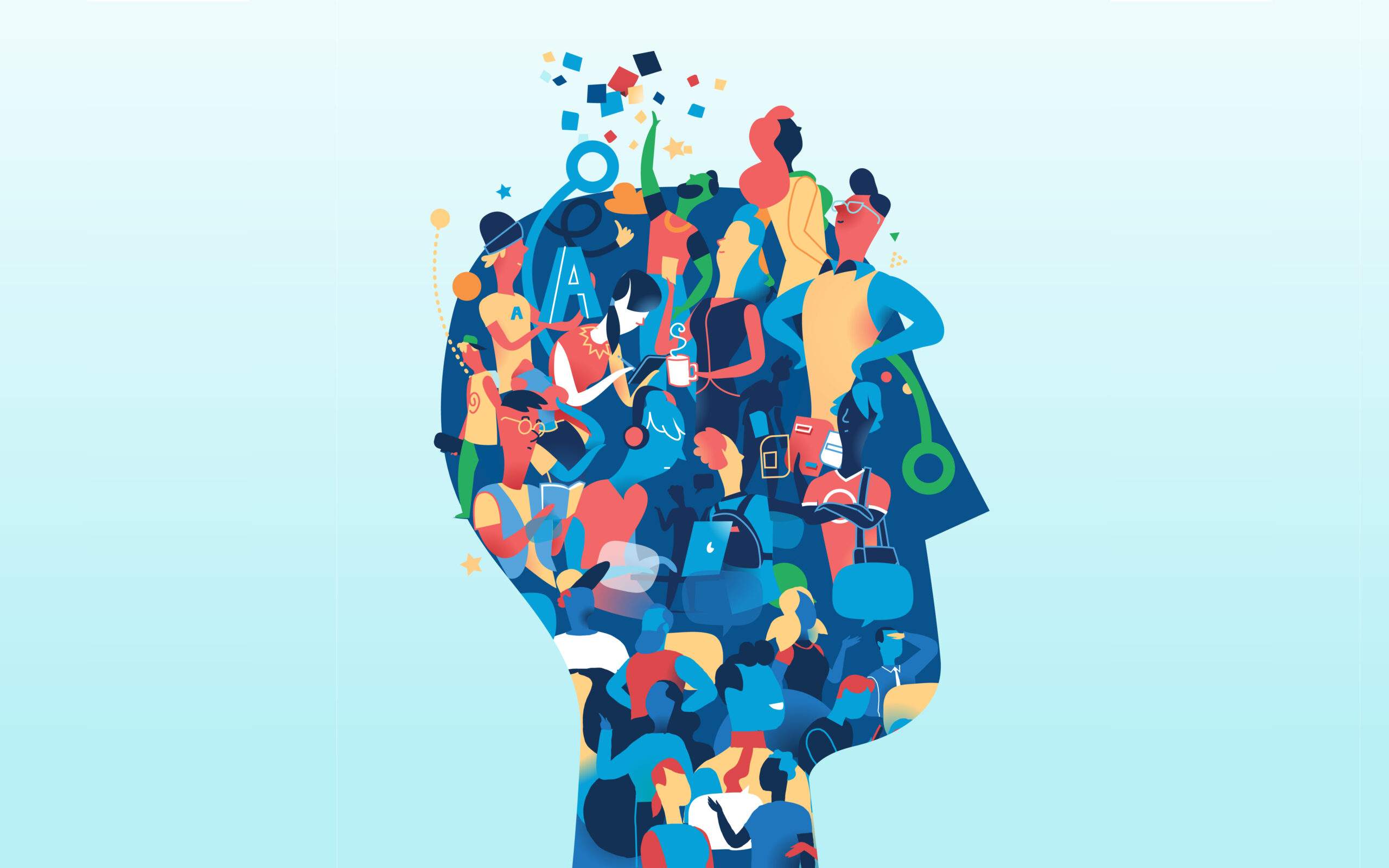We’re all learning all the time. Parents learn to care for children, students learn physics, soldiers learn survival skills, and all of us learn the latest app or how kale will make us healthy. But much of what we call learning isn’t particularly useful: I just “learned” on Facebook that someone I hardly know baked cupcakes today. Riveting!
Mindful learning, on the other hand, cultivates insightful knowing rather than just a brain overloaded with information. Mindfulness creates space to let new information in and to allow us to see how it relates to what we already know. Recent neurological research at Harvard shows how this happens: mindfulness may actually increase the size of your brain.
Mindfulness creates space to let new information in and to allow us to see how it relates to what we already know.
When I learned mindfulness practice in 1970, I felt for the first time in my life that I knew something to be absolutely true. I was breathing in and breathing out—that was really happening. I actually saw thoughts and judgments arise, like “I’m not nearly as good as these other meditators. Look, their backs are straighter than mine. They’re wearing the perfect white clothes. I’m in a funky embroidered shirt.”
Where did those thoughts come from? They arose in my mind, and then, if I wasn’t obsessing about them, they would float or fall away. The important thing was how I saw thoughts arise and disappear. I was beginning to see how my mind worked, and even if I didn’t like what it was doing, I felt more whole, more integrated, more confident. Not really knowing my breath or my mind seemed like not knowing what my face looked like. How could I have missed them? Of course we all know we are breathing and thinking, but it was radically different to experience them directly instead of intellectually. It wasn’t just an idea that I breathe—it was me breathing. I had learned something important in a whole new way.
That led me to look at the other ways we learn, to see whether they could benefit from mindfulness. I wanted to understand ideas, images, skills, and people in an intimate way, with the clarity and confidence I was experiencing as I came to know my own mind and body. I wanted to create space in my mind instead of that crowded carnival of ideas and information and judgments. I wanted to be open to learning something new, to see things with new perspectives and understanding. Mindfulness, with its focus, openness, inquisitiveness, and humility, seemed like the perfect approach.
Here are some of the practices I discovered.
1) Mindful Reading
Reading these days, whether on a screen or on paper, is more often a race to finish the text than a search for meaning. Woody Allen captured it: “I took a speedreading course and read War and Peace in 20 minutes. It involves Russia.”
Mindful reading is radically different. It slows down the reader and the reading—that alone changes the experience. It is a process of quiet reflection that requires mindful attentiveness, letting go of distracting thoughts and opinions to be fully in the moment with the text. It moves the reader into a calm awareness, allowing for a more profound experience and understanding.
Here are some mindful reading exercises:
The Wrap-Around
Before reading, sit quietly for some minutes. Bring your attention to your breath, letting go of thoughts and sensations, returning to the breath again and again. Then read. Notice if you read with more focus and appreciation. When you finish reading, sit again for some minutes, again bringing your mind to your breath. At the end of your practice, notice what you have learned from the reading.
Savoring a Resonant Phrase
Sit quietly and then read a short piece, perhaps a page long. What phrase stands out for you? Return to that phrase and repeat it to yourself, perhaps several times. Just sit with it. What does it evoke? Notice what images or ideas or memories arise. Do any of the words have meaning beyond the obvious? What meaning does this phrase give to the rest of what you’re reading? Hold the phrase in your mind, giving it time to suggest more to you. Now reread the full piece. How is it different? Has your relationship to it changed?
One from Many
Reading doesn’t have to be private. You can do this practice with as few as two people, but the more the merrier. Each person has a copy of the same poem or piece of prose. All sit quietly and focus on the breath. One person reads the entire text aloud. All sit in silence. After a while, one person reads the first line aloud. Out of the silence after that line, the next person who feels moved to read speaks the second line. And so on, until it is finished. Ask yourselves whether hearing the same words in different voices affects the meaning.
Mindful reading is radically different from racing to cram information in. It slows down the reader and the reading—that alone changes the experience.
2) Mindful Writing
Writing benefits from the capacities that mindfulness cultivates: seeing and hearing things just as they are, bearing witness to life; being in the moment, even when remembering the past or imagining the future; not judging others and oneself while still exercising discriminating wisdom; holding multiple perspectives; being open to the new; and practicing kindness, compassion, and patience. Mindful awareness helps us see, in Gerard Manley Hopkins words, “all things…original, spare, strange.”
At the same time, it acknowledges our interconnection. All of us, when we write, are giving something, and we need a reader who will accept our gift. We each write out of our own loneliness to express ourselves to another human being.
Here are some ways to bring mindfulness to your writing:
Journal Writing
Writing in a journal is one of the oldest methods of self-exploration and expression. Although they’re not written for publication and often don’t last longer than their authors, we have extraordinary examples of journals in the work of Virginia Woolf, Thomas Merton, May Sarton, and Anne Frank, among others. As these illustrate, a journal can help one cultivate the ability to live in the present, to become deeply aware and appreciative of life. There are many journal practices. Here are a few:
A journal can help one cultivate the ability to live in the present, to become deeply aware and appreciative of life.
Once a Day : Write something new every day. Add a drawing or a photograph to it. Journals, like mindfulness, help us appreciate the simple fact that every moment in our lives brings something new and different. We only need to notice it.
Be Your Own Researcher : Write each day what you are learning from mindfulness practice—or anything else.
Social Media Practice : Write about your experience of using social media. What sensations do you notice in your body before and after you communicate? What sensations do you notice when you receive a comment or tweet?
Being Here Now : Stop in your tracks once a day: take account of the sky, the ground, and yourself, then write what you noticed. Or, while walking down a street or country road, stop, turn in a circle, and write what you remember. Or, sitting with your notebook, write six sentences, beginning each with “Here and now….”
Mindful Emailing
Emailing allows us to get work done quickly with people around the globe. But without the emotional signs and social cues of face-toface or phone interaction, it’s more possible to be misunderstood—particularly if there’s trouble at hand. Also, mindless emailing overstuffs everyone’s inboxes.
Try this with 5 or 10 emails during the week. Or all of them.
- COMPOSE an email.
- STOP and take one long deep breath. Pay attention to the breath. You can count to five on the inhale and again on the exhale if you like.
- THINK of the person to whom the email is going and how you want them to receive your message. Could they misunderstand your words and become angry or offended, or think you’re being more positive than you intend?
- LOOK at the draft email again.
- CHANGE it if appropriate.
- SEND
Free Writing
Free writing is a method of mindful inner inquiry; you never know what you will learn until you start writing. Then you discover truths that you didn’t know existed.
Begin writing and write continuously for a set period of time, say 10 to 15 minutes. If it helps, use a prompt, like “Right now I am feeling….” Or, “I have always been afraid to ….” Keep the pen moving, with no pauses to correct spelling, grammar, or punctuation. Write down whatever is arising in your mind, without judgment. Keep writing. When the time is up, stop and read.
When you write, it’s possible not to judge others or yourself and still exercise discriminating wisdom, to hold multiple perspectives, and to be open to the new.
3) Mindful Listening
When we are listening mindfully, we are fully present with what we’re hearing without trying to control it or judge it. We let go of our inner clamoring and our usual assumptions, and we listen with respect to precisely what is being said. We listen to our own minds and hearts and, as the Quakers say, to the “still, small voice within.” We listen to sounds, to music, to lectures, to conversations, and, in a sense, to the written word.
For all of these kinds of listening to be effective, so we understand and remember what is being heard, we need a mind that is open, fresh, alert, attentive, calm, and receptive. We often do not have a clear concept of listening as an active process that we can control, but, in fact, mindful listening can be cultivated through practice.
Here are some mindful listening practices:
Wake Up Listening
Early morning is especially good for listening. Try this: As you wake up, instead of turning on the TV, your iPhone, or your computer, be still and just listen. In a rural setting, the sounds may be birds and animals waking up. In a city, sounds of outside action begin: garbage collection, building construction, traffic. On campus, the sounds of opening doors, feet walking in the hallways, other students talking. Listen for the soft sounds: a cat purring, leaves rustling. Rest your full attention on one sound until it fades away, then let another come to you. As thoughts come into your mind, gently let them go and return to the sound. Then get out of bed and enjoy the sound of the water on your skin in the shower.
In the Groove
Put on some music, maybe classical or slow tempo. Notice the sound and vibration of the notes, the sensations in your body as you listen, and the feelings the music brings up in you. When you notice thoughts arising, gently bring your attention back to the music. Breathe.
In the Shelter of Each Other
Thoreau said, “The greatest compliment that was ever paid me was when one asked me what I thought and attended to my answer.” Mindful listening helps us be fully present for another person. It is the gift of our attention. It moves us closer to each other. It allows the speaker to feel less vulnerable and more inclined to open up to the listener. Not listening creates separation and fragmentation, which is always painful.
To listen mindfully to another person, stop doing anything else, breathe naturally, and simply listen, without an agenda, to what is being said. If thoughts about other things arise, gently let them go and return to the speaker’s words. As responses arise in your mind, wait until you’ve heard all that has to be said before replying. Try not to let your story overcome the speaker’s. Be curious; don’t assume that you know. Listen for feelings as well as the words.
And you will want to be listened to also. But when you’re speaking, if the person you’re talking to doesn’t appear to be mindfully listening, be patient. As Winnie the Pooh once said, “It may simply be that he has a small piece of fluff in his ear.”
This article also appeared in the April 2014 issue of Mindful magazine.
more daily mindfulness practices
5 Simple Mindfulness Practices for Daily Life
Your day-to-day activities offer ample opportunities to call up mindfulness in any moment. These simple practices will breathe space into your daily routines.
Read More
Five Ways to Find Time to Pause
Feeling overwhelmed? Too busy to function? Here are five opportunities to pause, recharge your batteries, and stay on top of your game.
Read More
A Simple Weekly Mindfulness Practice: Keep a Gratitude Journal
Cultivate happiness by taking note of the good around you with this weekly journaling practice.
Read More










